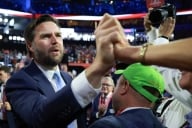You have /5 articles left.
Sign up for a free account or log in.
RICHMOND, VA. -- Four new members of the University of Virginia’s Board of Visitors and two new senior advisers are getting an introduction to the harsh limelight of national attention this week as the body meets for the first time since controversy consumed the board and the campus in June.
Back then, when board members forced the resignation of President Teresa Sullivan, relations between board members and the university’s administrators could be considered strained at best. Faculty members, who protested the board’s decision en masse, openly called for members to resign and questioned the board's legitimacy.
When the board unanimously reappointed Sullivan 18 days later, and when Gov. Robert F. McDonnell reappointed Helen E. Dragas, the board’s chair, to a second term on the board, higher education observers wondered whether the university’s administration would be able to function effectively and address the myriad stresses and strains highlighted during the June controversy.
The board’s meeting here this week -- under the microscope of local and national media attention -- is the first opportunity to gauge the status of various relationships and whether the institution has the cohesion to address those challenge. And so far discussion has been dominated by a strong desire to move past the events of this summer and try to look ahead.
“Even though we are not gathered in his beloved Albemarle County today, the words of Thomas Jefferson are never far from mind,” Dragas said in remarks to open the full board meeting. “He once advised that one should ‘take things always by their smooth handle.’ These words should guide us all as we return to where we started prior to June of this year -- with a focus on the people we all agree are paramount -- the University’s students and our medical center patients.”
Given that June’s controversy put the board at the center of a national conversation about the future of governing boards at public universities, how the institution moves forward and reshapes itself -- both its formal structure and its view of governance -- could influence many other institutions.
Moving On
This week’s discussion -- shaped largely by Sullivan -- kicked off Tuesday evening with an orientation for new board members who were joined by Sullivan, other university administrators, and Dragas. During those sessions there was little mention of the the debates of this summer, and the board covered topics that could be found at any board's orientation for new members. On Tuesday evening, the new members heard about the university’s core values, its academic organization, and its current challenges including faculty recruitment, assessment of students, and fund-raising. Wednesday morning the new members took up the university’s finances, medical center, and physical plant.
Relations between board members and administrators appeared mended. Sullivan, who at one point reportedly said she would not remain president with Dragas on the board, chatted amiably with the rector before meetings and during breaks.
The first mention of what happened this summer came at the opening of the full board meeting midday Wednesday, when Dragas reiterated her regret over the incident. “I again offer my sincere and personal apology for the controversies that, at best, have been distractions from the important work ahead of us,” she said. “Many have noted that today really affords us the chance ... to reconcile our differences, rejuvenate our leadership and reshape our future outcomes.”
While the mood is clearly forward-looking, many U.Va. constituents say that reconciliation is not enough. Last week a group of alumni called for the board to frankly address what happened in June and why board members asked for Sullivan’s resignation. The university's provost and deans also penned a letter at the end of July that called for the board to thoroughly examine governance structures -- including the board's composition and the university's relationship with the state -- before moving ahead with any strategic planning.
At lunch Wednesday, the board heard from Sam Parker, the father of an incoming U.Va. freshman and the co-founder of Give More Media, a company that consults with others to bring more positivity into the work place. While Parker’s speech didn’t hit on anything specific to U.Va., its message was one likely to bring a smile to the faces of those who watched the controversy unfold this summer. “We need to be sure to let our egos go,” he advised the board. He also noted that, in general, relationships are improved if “we give others the break we want to be given.”
Dominating Wednesday afternoon’s meeting of the full board was a discussion facilitated by Terrence MacTaggart, a senior fellow at the Association of Governing Boards of Universities and Colleges and a former leader of two public higher education systems.
Dragas brought MacTaggart in to talk about the qualities of high-performing boards and the proper role of board members in bringing about change at higher education institutions. During June’s controversies, many critics of the board said that members had overstepped their roles, trying to advocate specific policy changes instead of setting a general direction and supporting the president. (NOTE: This paragraph has been updated to correct an error.)
MacTaggart’s description of the best board is one that is more engaged and informed than in the past, but that still respects the president and her administration as the source of ideas to move the institution forward. “What, on the ground, actually separates the truly superior boards from the ones that are just merely good is straightforward,” MacTaggart said. “The best boards work with their presidents to build and sustain exceptional institutions.”
MacTaggart said the bar had been raised for trustees given the significant challenges that institutions such as U.Va. face in the next few years. Good boards, he said, fulfill their fiduciary duty while being champions of the institutions. Better boards do that, and also have “sophisticated, energetic, mature relationships and connections” among members that allow them to disagree cordially.
The best boards, he said, also bring good ideas to the table without forcing them on the institution. Boards that don’t give presidents latitude cannot be successful, he said. Boards that give too much leeway to presidents can find themselves in a situation where they aren’t being critical enough, referencing the findings of the Freeh Report at Pennsylvania State last month, link? dl which found that board members were not asking tough enough questions.
“What our focus is today, and what you’ll want to focus on in the years ahead, is asserting positive change leadership with your president,” he said. “This is a new level. This is the higher board challenge.”
MacTaggart also brought up a list of national issues affecting higher education that will color the university’s discussion over the next few years, many of which coincided with the list Dragas published in June justifying Sullivan’s removal. Those included shrinking state appropriations, increased global competition, increased concern among lawmakers and families about educational quality, and potential threats from low-cost providers.
Weighing In
The first -- and probably largest -- opportunity this year for the board members to view their roles through MacTaggart's model will be a strategic planning process, which became a controversial topic during this summer’s debate.
Board members initially criticized the administration, saying it was not strategically thinking about the major challenges facing the institution. At the same time, Sullivan said she had been specifically asked not to engage in a strategic planning process.
At the end of Wednesday’s meeting, two of the board’s new members, Frank B. Atkinson, a Richmond-based lawyer and consultant, and Linwood H. Rose, former president of James Madison University, proposed a process for the university's strategic plan. Atkinson and Rose will chair a strategic planning subcommittee created by the board to tackle the subject. The duo did not delve into what exactly the strategic plan would entail, opting to lay out a potential process and ask for feedback.
But the conversation here hinted at what will be on the table for those discussions. During the orientation sessions for new members, Sullivan mentioned faculty hiring and salaries as issues the board will hear about this year.
McDonnell released a letter Wednesday to the board members, presidents, and chancellors of all of Virginia’s public colleges and universities. In it, he touched on several topics that the U.Va. board and administration will probably take up when it begins its strategic planning process, including the role of technology deliver education new ways, the sharing of resources across institutions, and containing the cost of college for middle-class families.
The July letter by U.Va.’s provost and deans laid out what they hoped would be taken up in the strategic planning process. Primary among their concerns was a macro-level analysis of the governance relationship between the university, the board and the state. “The political nature of these issues means we cannot address them by ourselves, but that it must be a collective effort,” they wrote. “The resolution of these issues, however, will determine the context and important constraints within which the academic community plans its long-term future.”
Today the board will start one of those conversations: how it organizes itself. The outcome of that discussion could have broad ramifications for the university’s ability to continue to move past June’s controversy and prevent similar occurrences in the future.








